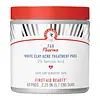What's inside
What's inside
 Key Ingredients
Key Ingredients

 Benefits
Benefits

 Concerns
Concerns

 Ingredients Side-by-side
Ingredients Side-by-side

Salicylic Acid
MaskingWater
Skin ConditioningPolysorbate 80
EmulsifyingPhenoxyethanol
PreservativeSodium Hydroxide
BufferingGlycerin
HumectantSodium Citrate
BufferingKaolin
AbrasiveSalix Nigra Bark Extract
Skin ProtectingRosmarinus Officinalis Leaf Oil
MaskingButylene Glycol
HumectantPotassium Sorbate
PreservativeSodium Benzoate
MaskingCamellia Sinensis Leaf Extract
AntimicrobialChrysanthemum Parthenium Extract
Skin ConditioningGlycyrrhiza Glabra Root Extract
BleachingCapryloyl Glycine
CleansingHexylene Glycol
EmulsifyingMelaleuca Alternifolia Leaf Oil
AntioxidantSarcosine
Skin ConditioningLeuconostoc/Radish Root Ferment Filtrate
AntimicrobialEnantia Chlorantha Bark Extract
Skin ConditioningEpilobium Angustifolium Flower/Leaf/Stem Extract
Skin ConditioningCinnamomum Zeylanicum Bark Extract
AntimicrobialXanthan Gum
EmulsifyingLimonene
PerfumingOleanolic Acid
Skin ConditioningSalicylic Acid, Water, Polysorbate 80, Phenoxyethanol, Sodium Hydroxide, Glycerin, Sodium Citrate, Kaolin, Salix Nigra Bark Extract, Rosmarinus Officinalis Leaf Oil, Butylene Glycol, Potassium Sorbate, Sodium Benzoate, Camellia Sinensis Leaf Extract, Chrysanthemum Parthenium Extract, Glycyrrhiza Glabra Root Extract, Capryloyl Glycine, Hexylene Glycol, Melaleuca Alternifolia Leaf Oil, Sarcosine, Leuconostoc/Radish Root Ferment Filtrate, Enantia Chlorantha Bark Extract, Epilobium Angustifolium Flower/Leaf/Stem Extract, Cinnamomum Zeylanicum Bark Extract, Xanthan Gum, Limonene, Oleanolic Acid
Salicylic Acid 2%
MaskingWater
Skin ConditioningC12-15 Alkyl Benzoate
AntimicrobialButylene Glycol
HumectantCetyl Alcohol
EmollientDimethicone
EmollientDimethicone PEG-8 Beeswax
EmollientGlyceryl Stearate
EmollientPEG-100 Stearate
Potassium Cetyl Phosphate
EmulsifyingCapryloyl Glycine
CleansingHydrogenated Palm Glycerides
EmollientAcrylates/C10-30 Alkyl Acrylate Crosspolymer
Emulsion StabilisingXanthan Gum
EmulsifyingSarcosine
Skin ConditioningSodium Hydroxide
BufferingPropylene Glycol
HumectantParfum
MaskingTocopheryl Acetate
AntioxidantCinnamomum Zeylanicum Bark Extract
AntimicrobialBisabolol
MaskingAllantoin
Skin ConditioningCedrus Atlantica Bark Extract
PerfumingPortulaca Oleracea Extract
Skin ConditioningCitric Acid
BufferingSalicylic Acid 2%, Water, C12-15 Alkyl Benzoate, Butylene Glycol, Cetyl Alcohol, Dimethicone, Dimethicone PEG-8 Beeswax, Glyceryl Stearate, PEG-100 Stearate, Potassium Cetyl Phosphate, Capryloyl Glycine, Hydrogenated Palm Glycerides, Acrylates/C10-30 Alkyl Acrylate Crosspolymer, Xanthan Gum, Sarcosine, Sodium Hydroxide, Propylene Glycol, Parfum, Tocopheryl Acetate, Cinnamomum Zeylanicum Bark Extract, Bisabolol, Allantoin, Cedrus Atlantica Bark Extract, Portulaca Oleracea Extract, Citric Acid
Ingredients Explained
These ingredients are found in both products.
Ingredients higher up in an ingredient list are typically present in a larger amount.
Butylene Glycol (or BG) is used within cosmetic products for a few different reasons:
Overall, Butylene Glycol is a safe and well-rounded ingredient that works well with other ingredients.
Though this ingredient works well with most skin types, some people with sensitive skin may experience a reaction such as allergic rashes, closed comedones, or itchiness.
Learn more about Butylene GlycolCapryloyl Glycine is created by adding an acyl group to glycine and caprylic acid chloride.
It is a cleanser due to its surfactant properties. Surfactants help dirt, oil, and other polluants be more easily rinsed away. According to manufacturers, Capryloyl Glycine also helps soften the skin and regulate sebum production.
Emerging studies show Capryloyl Glycine may inhibit hair growth. It may also cause allergies for some people. We recommend speaking with a professional if you have any questions about this ingredient.
Learn more about Capryloyl GlycineThis cinnamon tree also called true cinnamon or Ceylon cinnamon. It has antimicrobial, emollient, skin hydrating, and antioxidant properties.
This tree is native to Sri Lanka.
Salicylic Acid (also known as beta hydroxy acid or BHA) is a well-known ingredient for treating skin that struggles with acne and clogged pores. It exfoliates both the skin's surface and deep within the pores to help clear out buildup, control oil, and reduce inflammation.
Unlike AHAs (alpha hydroxy acids), salicylic acid is oil-soluble. This allows it to penetrate into pores which makes it especially effective for treating blackheads and preventing future breakouts.
Salicylic acid is also known for its soothing properties. It has a similar structure to aspirin and can calm inflamed or irritated skin, making it a good option for acne-prone skin that is also sensitive.
Concentrations of 0.5-2% are recognized by the U.S. FDA as an over-the-counter topical acne product.
It can cause irritation and/or dryness if one's skin already has a compromised moisture barrier, so it's best to focus on repairing that before introducing this ingredient into your routine.
While salicylic acid does not increase sun sensitivity, it’s still important to wear sunscreen daily to protect your skin.
If you are looking for the ingredient called BHA or Butylated Hydroxyanisole, click here.
Learn more about Salicylic AcidSarcosine is a skin conditioning ingredient. It is a synthetic amino acid.
It is an intermediate and byproduct in glycine synthesis and degradation. Glycine is an amino acid naturally found in our skin.
This ingredient also goes by the name of methylglycline.
Learn more about SarcosineSodium Hydroxide is also known as lye or caustic soda. It is used to adjust the pH of products; many ingredients require a specific pH to be effective.
In small amounts, sodium hydroxide is considered safe to use. However, large amounts may cause chemical burns due to its high alkaline.
Your skin has a natural pH and acid mantle. This acid mantle helps prevent harmful bacteria from breaking through. The acid mantle also helps keep your skin hydrated.
"Alkaline" refers to a high pH level. A low pH level would be considered acidic.
Learn more about Sodium HydroxideWater. It's the most common cosmetic ingredient of all. You'll usually see it at the top of ingredient lists, meaning that it makes up the largest part of the product.
So why is it so popular? Water most often acts as a solvent - this means that it helps dissolve other ingredients into the formulation.
You'll also recognize water as that liquid we all need to stay alive. If you see this, drink a glass of water. Stay hydrated!
Learn more about WaterXanthan gum is used as a stabilizer and thickener within cosmetic products. It helps give products a sticky, thick feeling - preventing them from being too runny.
On the technical side of things, xanthan gum is a polysaccharide - a combination consisting of multiple sugar molecules bonded together.
Xanthan gum is a pretty common and great ingredient. It is a natural, non-toxic, non-irritating ingredient that is also commonly used in food products.
Learn more about Xanthan Gum